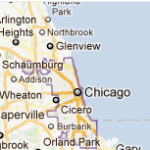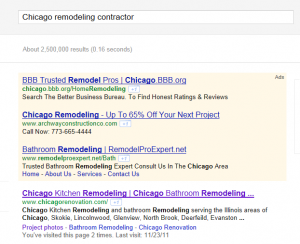Do B2B companies understand the importance of their content during the holidays? I didn't think about it until I read Steve Keifer's blog post on the GXS website. He's Vice President of Industry and Product Marketing for the company.
Eight Easy Ways Contractors Can Optimize Content for Local Search
 To beat your competition in local search, contractors need to find ways to incorporate local content on their websites as well as on third party sites where their businesses are listed. This might sound more difficult than it really is. Here are a few suggestions:
To beat your competition in local search, contractors need to find ways to incorporate local content on their websites as well as on third party sites where their businesses are listed. This might sound more difficult than it really is. Here are a few suggestions:
1) Put your physical address and phone on every page of your website.
2)Add city, state or neighborhood data to all of your construction project photos.
3)Add city and state info to your customer testimonials.
4) Promote your involvement with local charities and business organizations online through press releases. Use location names in the headlines.
5) Create a page for each location of your business and be sure to include it on the site map you submit to search engines. Each page should feature unique images and information pertinent to the location. Maps and directions are useful geographic content.
6) Claim your business on search engine directories such as Google Places, Yahoo! , Bing and the Yellow Pages as well as B2B directories, if that is your target audience. Enhance your listings with photos, graphics and links to social media sites, where available. Be sure to include the cities and suburbs you will serve. A convenient way to find out if your business currently appears in these directories is to visit www.getlisted.org. It will give you a full report in just a few seconds and links directly to where you can update your information.
7)Blog posts are the perfect way to add geographic emphasis to headlines , so you can rank higher with search engines. Whenever you post a project photo or news item, don’t forget to mention the location. This ensures the local keywords show up in the <title> tag, where Google and other search engines pull content from.
8)Claim your listings on review sites such as Angie’s list, Yelp and Google Places. Encourage reviews by adding badges to your website and e-newsletter.
A Good Example of Local Search Optimization by a Contractor
If you want to see a good example of a contractor website that is optimized for local search visit Chicago Renovation Development. They came up No. 1 in my search for “Chicago remodeling contractor.”
The home page includes location-based content focused on Chicago remodeling. In the footer of each page are three links to” leading Glencoe Remodeling Contractor,” “Highland Park Remodeling Contractor” and “Winnetka Remodeling Contractor.” Click on any of these and you will find a page of unique content, as well a complete listing of service areas. A badge for reviews is a highlight on the home page.
Type in a relevant local search term for your business and it is easy to see who is doing it well among your competition. With an estimated 20 percent of all searches (40 percent of local searches) made with local intent, you don’t want to miss this opportunity. Put these painless and highly cost-effective ways to improve your local search engine rankings on your to-do list today.
Can an Online Product Demo Help Your Sales?
Is your sales force sending mixed messages? Are your marketing materials gathering dust in the reception area? Do you want your content to sell products? A product demo can generate qualified leads and be shared on multiple platforms including sales team laptops and YouTube. Product demos can help ensure a consistent message and maximize your return on investment by engaging your prospects.
When it Comes to Home Page Design, Think Fast
 According to web usability expert Jakob Nielson, website visitors will typically spend less than 20 seconds reading a web page. A serious B2B buyer has no time to spend on irrelevant or difficult to navigate websites. Time is of the essence. As a B2B marketer, you need to make those seconds count. In 20 seconds or less you need to build trust with B2B buyers, communicate what your firm does, and explain how you are different or better than your competition. Here are four ways to make your home page communicate fast.
According to web usability expert Jakob Nielson, website visitors will typically spend less than 20 seconds reading a web page. A serious B2B buyer has no time to spend on irrelevant or difficult to navigate websites. Time is of the essence. As a B2B marketer, you need to make those seconds count. In 20 seconds or less you need to build trust with B2B buyers, communicate what your firm does, and explain how you are different or better than your competition. Here are four ways to make your home page communicate fast.
Use Visuals to Communicate Faster than Words
What markets are you focused on? Who recommends you? What do you want me to do next? These are all questions that potential customers want answered quickly. Visual images communicate the answers faster than words. What is your visual content strategy?Photos can show your involvement in specific industries. Recognizable logos from organizations such as the Better Business Bureau, Angie’s List or trade associations show visitors you are a reputable firm. Graphic buttons and design point the way to the next click.
Cut Your Copy: Concise Copy Performs Better
Who is your firm and what do you do? Leave generic taglines, industry jargon and a lengthy list of services in your briefcase. Be concise and specific about what you do, including the keywords you believe people are searching for. Cut out unnecessary “marketing speak” that isn’t fact-based. In usability studies conducted by Nielson, users found shorter versions of web pages–with 54% less text–more complete than longer versions.
Make it a Quick Read with Copy Users Can Scan
Studies show website visitors don’t read, they scan. To quickly communicate, focus on benefit-laden headlines and keep paragraphs short. Highlight keywords and other information in bold. Utilize bullets or numbered lists to make scanning website copy easier.
Avoid Information Overload
Resist the urge to add more content to an already crowded home page. Instead, reorganize content into easy-to-digest chunks. Keep the 20-second time frame in mind when deciding what should stay and what should go.
Remember less is often more in online communications.
Five Tips on Web Writing That Engages
Web writing that engages allows visitors to quickly find what they need, reduces task errors, is memorable, and leaves the visitor feeling satisfied. When you optimize your content for easy consumption, you entice. When you educate, you build trust. When you differentiate, you become memorable.

